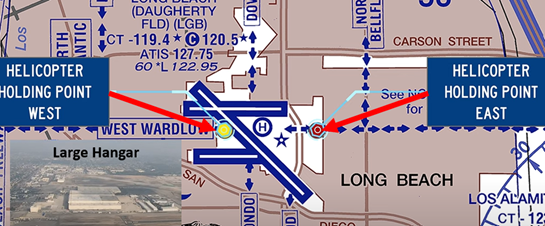Long Beach Airport (Daugherty Field) (LGB)
Long Beach Airport (LGB), also known as Daugherty Field, is in the city of Long Beach, California. Situated fifteen (15) miles southeast of the larger, more congested Los Angeles International Airport (LAX), it is a convenient alternative for general aviation. View a printable Pilot Handbook of the LGB information found on this Web page.
Know Before You Go
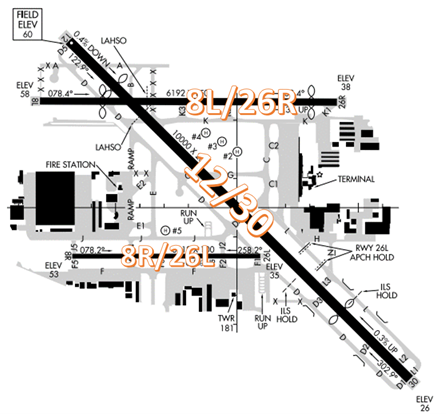
TWR Hours: 0615L-2345L
Business Hours: 0700L-1500L
M-F Phone Number: 562-424-7128
The RWY configuration consists of parallel RWYs 8L/26R and 8R/26L. The thresholds on these RWYs are staggered.
A third RWY, designated RWY 12/30, runs diagonally across the parallel RWYs.
A complex TWY system provides access to all services.
The airspace at LGB is Class D. It is adjacent to Los Alamitos Army Airfield (SLI) airspace and underlies Los Angeles Class Bravo airspace. (Refer to Sectional Chart.)
There are at least five additional airports of varying sizes within a 10-mile radius of LGB.
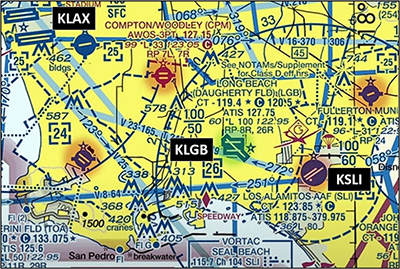
Wrong Surface Landing Risk
- Wrong Surface Landing risk exists at LGB due to parallel RWYs with staggered thresholds.
- This risk is compounded in the late afternoon when landing to the west due to the position of the sun.
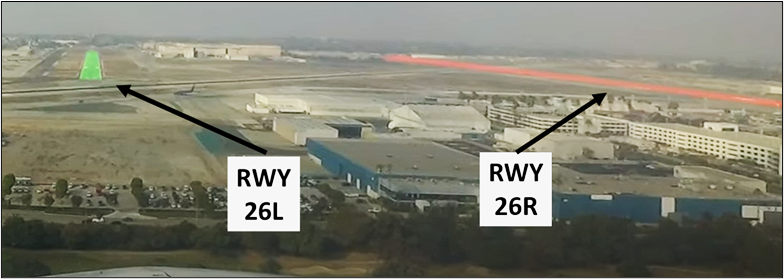
- The glare makes it difficult to see and aircraft can line up for the wrong RWY. If this is the case and you want to double check, just ask if you are lined up correctly or go around.
- Sometimes TWR will turn on the RWY lights during this time of day to help pilots see the RWY. Even though it is daylight, this seems to help.
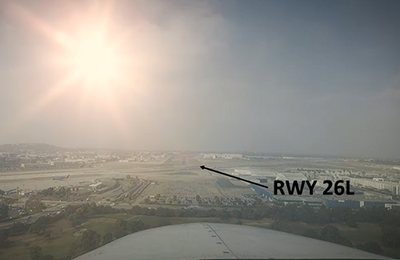
- Whenever a TWY runs parallel to a RWY, the risk of landing on a TWY increases.
- If available, back up all visual approaches with an instrument approach/GPS Waypoint to help ensure that you are lined up for the correct surface.
- View the From the Flight Deck-Wrong Surface Landings video for additional mitigation strategies
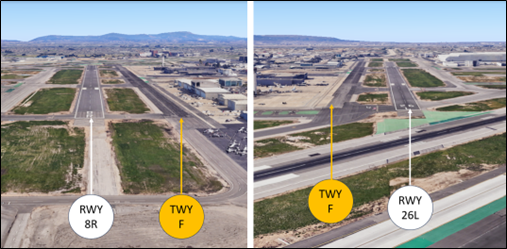
Wrong Direction Intersection Takeoff
- At LGB, or at any airport where intersection take-offs are authorized, there is the risk that pilots will turn in the wrong direction when entering the RWY. At LGB Intersection departures are common though turning onto the RWY in the wrong direction is rare. Be aware that this risk always exists.
- During west flow configuration, RWY 30 is the only RWY authorized for intersection departures.
- Prior to entering the RWY and again when lining up on the RWY, CHECK YOUR MAGNETIC COMPASS and HORIZONTAL SITUATION INDICATOR (HSI), if installed, to verify that you are pointed in the correct direction.
- View From the Flight Deck-Wrong Direction Intersection Takeoffs.
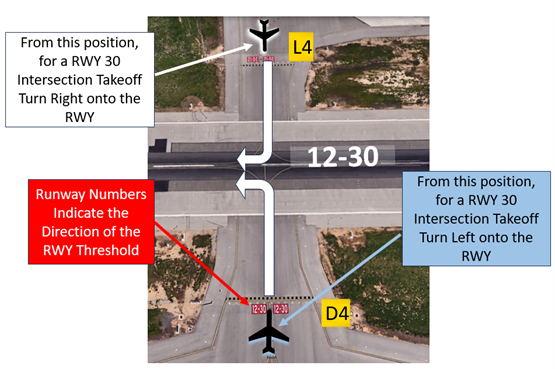
Wrong Airport Landing Risk
- Pilots have landed or attempted to land at Los Alamitos Army Airfield (SLI) which is located just southeast of LGB.
- During pre-flight planning, check the sectional chart for airports in close proximity and charted reporting points.
- Use navigational aids such as GPS, localizers, or VOR radials to positively identify the airport.
- View the From the Flight Deck-Wrong Airport Landings video for more information and mitigation strategies.
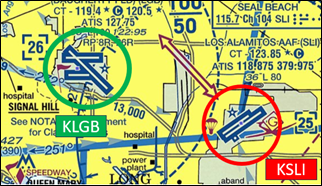
General Information
- Check NOTAMS for nightly RWY closures.
- Always use caution for possible jet blast or wake turbulence. Traffic ranges from primary civil training aircraft utilized by multiple flight schools to helicopters and large military transports.
- 6 ft. lighted chain link fence located 130’ south of centerline of TWY F. The fence begins at the NW corner of the TWR and extends 400’ to the west.
- There is no TWY access to RWY 8L west of TWY D - 4850’ remaining on RWY 8L from TWY D.
Clearance Delivery
- Pilots should contact Clearance Delivery prior to contacting Ground Control when ready to taxi.
Ground Control (GC)
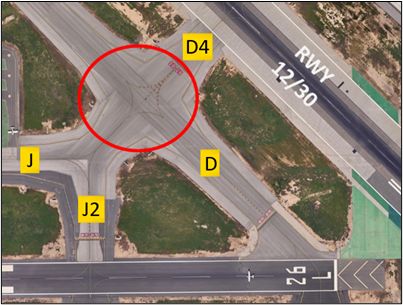
- Always read back all RWY Hold Short instructions and include your callsign.
- We have three Run-Up Areas but two are marked differently. Pay attention to these run-up area markings.
- The run-up areas off TWYs J and F are non-movement and require a call.
- The run-up area off TWY K near RWY 26R has no markings and is part of the movement area. Here you can exit without calling GC.
- Run-up areas are not named but we sometimes refer to the one off TWY J as the “Juliet Run-up”. Though not officially named, we reference them to the bordering TWY.
- RWY 26L has an Approach Hold. When you are instructed to “hold short of RWY 26L Approach Hold”, you must read it back and hold short. If TWR omits the instruction to hold short at this point, you may continue taxiing to the RWY without stopping.
- Aircraft outbound from the west ramp via TWY J and TWY J4 must not exit the ramp to the south across the green island directly onto TWY J4. Make the turn onto TWY J to avoid entering RWY 8R/26L.
- At the intersection of TWY J and TWY D, the large expanse of pavement sometimes confuses pilots, and they usually stop. Stay on TWY centerline. If you are ever unsure about your position or instructions, ask the TWR.
Traffic Patterns
- Be aware that LGB issues a lot of instructions in the pattern. If you are in the traffic pattern for RWY 26L, your downwind leg will be north of the 405 Freeway. This downwind needs to be close because of RWY 30 arrivals. This pattern will fly directly over RWY 30 arrivals; therefore, you cannot descend until you are east of the RWY 30 centerline.
- If you are in the pattern for RWY 26R, make sure you comply when instructed to extend upwind. This is usually given for a RWY 30 departure, and we are delaying your turn to crosswind.
Arrival/Landing
- LGB Controllers will utilize VFR Reporting Points such as Signal Hill to manage arrival traffic. If unfamiliar, inform ATC and they will provide alternate instructions.
- Upon entering left downwind RWY 26L, all aircraft must remain north of Signal Hill unless otherwise specifically instructed.
- All aircraft established on/entering left downwind for RWY 26L are not authorized to turn base or begin descent until east of RWY 30 unless specifically instructed by ATC.
- All aircraft on downwind RWY 8L are not authorized to turn base or begin descent until west of RWY 12 unless specifically instructed by ATC.
- Aircraft entering the pattern for RWY 26L on the 45 deg from the south, should fly directly over Signal Hill.
- Land and Hold Short (LAHSO) is utilized during simultaneous intersecting runway operations to RWYs 26/30 and may be issued to general aviation aircraft. Advise if you are unable to participate.
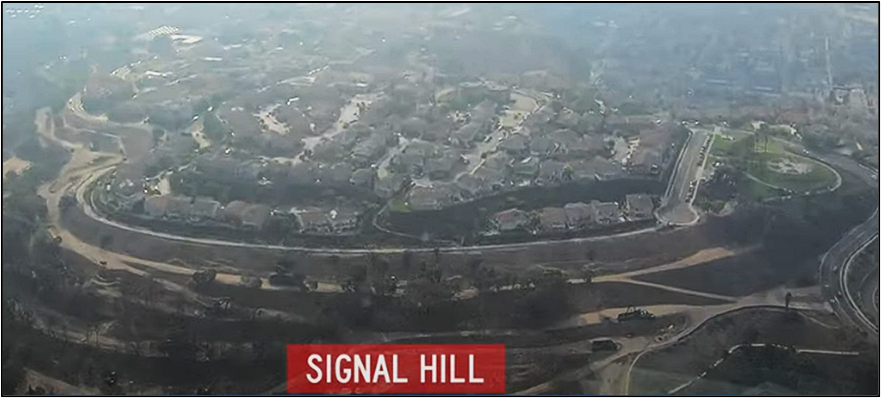
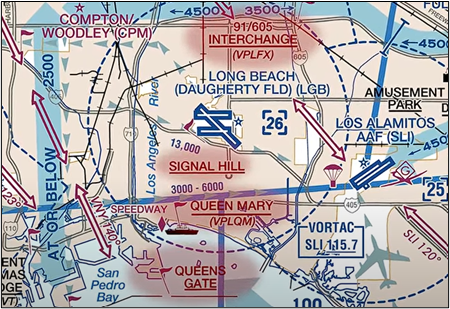
| LDG RWY | HOLD-SHORT POINTS | AVBL LDG DIST |
|---|---|---|
| RWY 26R | 12/30 | 3400 |
| RWY 30 | 8L/26R | 5850 |
- When landing RWY 26L/R, helicopters operate on helipads between the RWYs. Be aware that you may see helicopters off to your side.
- In the event of a go-around, TWR may issue traffic to you.
- RWY 30 arrivals must be aware that RWY 26L will cross over you on final. They should be at 1000’ AFE’.
- Some pilots are unsure of which direction to turn after landing. To assist, TWR may instruct “Turn left or Right”, allowing the pilot to choose their direction for parking. You may also hear “Say parking” from TWR while on final or during roll out.
Runway Exiting
- When clearing the RWY after landing, be sure to taxi completely across the Hold Short Lines for the RWY behind you. You are not clear of the RWY until your entire aircraft is across this line.
- Expect to exit RWY 30 at TWY D4 or TWY L4 (or at your earliest available exit) because larger following aircraft may be close in trail. Tower may use phraseology such as “no delay off the runway”. In any event, exit the runway when you are safely able to do so.

Special Traffic (Military/Commercial/Helicopter, etc.)
- Helicopters inbound to the field from the north and south enter the traffic pattern between the parallel RWYs by crossing either RWY 26L or 26R midfield at 500’ to join a downwind leg.
- Helicopters may also enter a holding point east of the terminal building or west of RWY 12/30 over the large hangar.
- Use caution for Airships moored in the infield and operating in the vicinity of the airport.
- CAUTION: There will be times when multiple military aircraft will be operating out of LGB, such as during Los Angeles Fleet Week. Along with fighter jets and heavy military transport aircraft, this will also include large helicopters from law enforcement and fire first-responders, and the U.S. Coast Guard.
